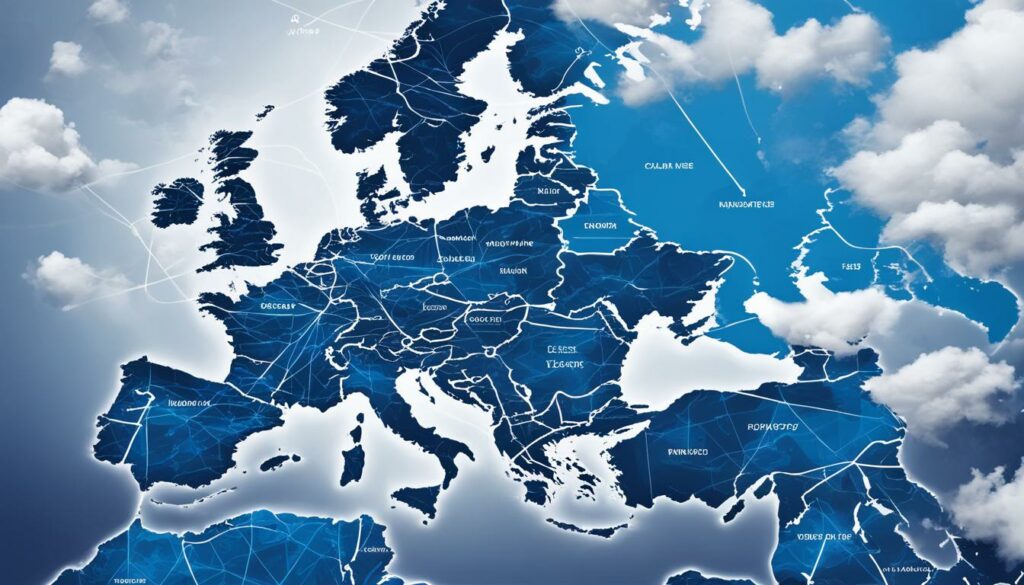Welcome to our comprehensive guide on cloud computing in Europe. In this article, we will explore the latest trends, best practices, and the thriving European cloud computing market. Cloud technologies have revolutionized the way businesses operate, providing efficient and scalable solutions for various industries.
Cloud adoption in Europe is on the rise, with 41% of European enterprises already using cloud computing services. This growth is driven by numerous factors, including the need for enhanced operational efficiency, cost reduction, and agile scalability. As technology continues to advance, cloud computing solutions in Europe are constantly evolving, offering businesses a competitive edge in the digital landscape.
Within the European cloud computing market, there are several key trends and advancements to be aware of. From the increasing adoption of Software as a Service (SaaS) to the development of robust cloud infrastructures, European businesses are leveraging cloud technologies to drive innovation and improve their bottom line.
When it comes to cloud computing in Europe, best practices are essential to ensure optimal performance, data security, and compliance with regulations. European businesses need to navigate the complex landscape of data sovereignty, privacy protection, and infrastructure requirements. By adhering to best practices, businesses can maximize the benefits of cloud computing while mitigating potential risks.
Now, let’s dive deeper into the state of cloud computing in Europe, exploring adoption rates in different countries, prevalent service models, European regulations, and the shift towards edge computing. By understanding these key aspects, you’ll gain valuable insights into the current landscape and future prospects of cloud computing in Europe.
Key Takeaways:
- Cloud adoption in Europe is steadily increasing, with 41% of enterprises currently using cloud computing services.
- The European cloud computing market is driven by the need for operational efficiency, cost reduction, and scalability.
- Best practices play a crucial role in ensuring optimal performance, data security, and compliance with European regulations.
- European cloud computing trends include the adoption of SaaS, the development of robust cloud infrastructures, and the emergence of edge computing.
- Key challenges in cloud computing include data security, compliance, vendor lock-in, and data sovereignty concerns.
The State of Cloud Computing in Europe
According to a report by Eurostat, 41% of European enterprises used cloud computing services in 2021. The adoption of cloud technologies varies across EU countries, with Sweden and Finland leading the way with 75% of enterprises using cloud services. The usage of advanced cloud services, such as application security and enterprise database hosting, also saw a significant increase. Cloud services are most widely used in the information and communication industry and professional, technical, and scientific sectors. Large companies have the highest adoption rate, but there is also an increasing number of medium and small companies embracing cloud technologies.
Cloud Adoption by Enterprise Size
| Enterprise Size | Cloud Adoption Rate |
|---|---|
| Large Companies | High |
| Medium Companies | Increasing |
| Small Companies | Embracing the Cloud |
Cloud Computing Adoption in EU Countries
The adoption of cloud computing services varies among EU countries, with some leading the way in embracing cloud technologies, while others have slower adoption rates. Let’s take a closer look at the cloud adoption landscape across Europe.
Cloud Adoption Rates by Country
Sweden and Finland are the frontrunners when it comes to cloud adoption in EU countries, with an impressive 75% of enterprises utilizing cloud services. This highlights the forward-thinking approach of these nations in embracing the potential of cloud computing.
The Netherlands, Denmark, and Italy also demonstrate high adoption rates, ranging from 60% to 65%. These countries are recognizing the benefits that cloud services bring to businesses, such as scalability, cost-efficiency, and improved agility.
However, there are countries in the EU that have lower adoption rates. Greece, Romania, and Bulgaria fall below the average, with less than 25% of enterprises utilizing cloud services. These countries may face challenges in terms of infrastructure development and awareness of the benefits of cloud computing.
Industry and Sector Trends
When examining cloud usage by industry, the information and communication industry leads the way in cloud adoption throughout Europe. This is followed closely by the professional, technical, and scientific sectors. These industries understand the importance of cloud services in enhancing productivity, enabling collaboration, and driving innovation.
On the other hand, industries such as construction and manufacturing lag behind in terms of cloud adoption. These sectors may require more education and support to fully leverage the benefits of cloud computing for their specific business needs.
Key Takeaways
The cloud adoption landscape in EU countries is varied, with leaders like Sweden and Finland setting an example for others to follow. The Netherlands, Denmark, and Italy also demonstrate strong adoption rates, while countries such as Greece, Romania, and Bulgaria have room for growth.
As businesses across different industries continue to recognize the advantages of cloud computing, we can expect to see a further increase in cloud adoption in EU countries. The benefits of scalability, cost-efficiency, and improved productivity are driving enterprises to embrace cloud technologies, unlocking new opportunities for growth and innovation.
| Country | Cloud Adoption Rate |
|---|---|
| Sweden | 75% |
| Finland | 75% |
| The Netherlands | 60% |
| Denmark | 65% |
| Italy | 60% |
| Greece | Less than 25% |
| Romania | Less than 25% |
| Bulgaria | Less than 25% |
Stay tuned for the next section, where we will explore the different cloud service models available in Europe and how enterprises are leveraging them to achieve their business goals.
Cloud Service Models in Europe
In Europe, cloud computing has gained widespread adoption, with companies leveraging different service models to meet their specific business needs. Let’s take a closer look at the three main cloud service models in Europe: Software as a Service (SaaS), Infrastructure as a Service (IaaS), and Platform as a Service (PaaS).
Software as a Service (SaaS)
SaaS is the most widely used cloud service model in Europe, with a staggering 94% of companies utilizing it for various purposes. SaaS provides access to software applications hosted on the cloud, allowing users to access them through a web browser without needing to install or maintain the software locally. This model is commonly used for email, office applications, finance, accounting, security, and more.
Infrastructure as a Service (IaaS)
IaaS is another popular cloud service model in Europe, with 74% of enterprises adopting it. With IaaS, businesses can outsource their IT infrastructure, including servers, storage, and networking resources, to cloud service providers. This enables them to scale resources up or down as needed, without the hassle of managing physical infrastructure. Common use cases of IaaS include database hosting, file storage, and computing power.
Platform as a Service (PaaS)
PaaS is slightly less prevalent in Europe, with 21% of enterprises utilizing it. PaaS provides a platform for developers to build, test, and deploy web applications without worrying about the underlying infrastructure. It offers a complete development and deployment environment, including tools, frameworks, and server infrastructure. PaaS is commonly used for application development, testing, and deployment.
These cloud service models offer significant benefits to businesses in Europe. They provide flexibility, scalability, and cost-efficiency, allowing companies to focus on their core competencies while leveraging state-of-the-art technology. By adopting these cloud service models, European enterprises can accelerate innovation, improve productivity, and achieve strategic business objectives.
Now, let’s visualize the adoption of cloud service models in a table:
| Cloud Service Model | Percentage of Adoption |
|---|---|
| Software as a Service (SaaS) | 94% |
| Infrastructure as a Service (IaaS) | 74% |
| Platform as a Service (PaaS) | 21% |
As seen in the table, SaaS has the highest adoption rate, followed by IaaS and PaaS. This data highlights the popularity and importance of each cloud service model in Europe.

This image showcases the diverse cloud service models and their significance in Europe’s digital landscape.
In the next section, we will delve into the European regulations governing cloud computing, ensuring data security, privacy protection, and fair competition in the cloud market.
European Regulations for Cloud Computing
In the dynamic landscape of cloud computing, European regulations play a crucial role in ensuring data sovereignty, privacy protection, and fair competition. The European Union has established a comprehensive framework of regulations and requirements for cloud service providers operating in Europe.
The European Cloud Rulebook:
The European Cloud Rulebook sets forth guidelines and standards that cloud service providers must comply with in order to safeguard the data of European businesses and individuals. It outlines the technical and operational requirements, ensuring that cloud infrastructure is secure, reliable, and resilient.
Guidance on public procurement of data processing services:
The European Union has also issued guidance on public procurement of data processing services. This guidance empowers public authorities to make informed decisions when procuring cloud services, taking into consideration security, privacy, and performance criteria.
To enhance data security, European cybersecurity certification schemes have been established, such as the European Cybersecurity Certification Scheme for cloud services (EUCS). These schemes provide organizations and individuals with increased assurance that their data is being handled securely and in accordance with European data protection regulations.
Major cloud infrastructure providers:
Leading cloud infrastructure providers, including Google, Microsoft, and AWS, are actively adapting to European regulations to provide secure and sovereign cloud services. These providers have implemented robust security measures and data protection protocols to ensure compliance with European data protection regulations.
By adhering to European regulations, cloud service providers contribute to building trust among European businesses and individuals, fostering a secure and reliable cloud computing ecosystem in Europe.
| Benefits | Challenges |
|---|---|
|
|
Cloud Computing and the Shift to Edge Computing
The shift to edge computing is revolutionizing the cloud computing landscape in Europe. With the increasing demand for real-time data processing and reduced latency, edge computing has emerged as a game-changer. By 2025, it is predicted that 80% of data will be processed in smart devices closer to the user, heralding a new era of efficient data management.
The European Union’s Digital Decade objectives recognize the immense potential of cloud-edge technologies. The goal is to facilitate the adoption of these technologies by 75% of European businesses and to deploy 10,000 climate-neutral and highly secure edge nodes across the region.
Edge and cloud infrastructures are key to ensuring secure and sustainable data storage, seamless transmission, and efficient processing. By enabling data processing at the edge of the network, closer to the source, edge computing minimizes the need for transferring large amounts of data to centralized cloud servers. This not only reduces latency but also enhances data privacy and security.
Embracing edge computing enables businesses to make the most of emerging technologies such as Internet of Things (IoT), artificial intelligence (AI), and autonomous vehicles. These technologies heavily rely on real-time data analysis and immediate response, which can be achieved through edge computing.
With the EU Digital Decade objectives driving the adoption of cloud-edge technologies, Europe is poised to become a global leader in this space. The region’s commitment to sustainability and data sovereignty aligns perfectly with the edge computing paradigm, creating a fertile ground for innovation and economic growth.
Edge Computing Trends in Europe
To provide you with a glimpse of the edge computing landscape in Europe, here are some key trends:
- Increased adoption: European businesses are increasingly realizing the benefits of edge computing, leading to a surge in adoption across various industries.
- Expansion of edge nodes: The deployment of edge nodes is rapidly expanding, with a focus on establishing a robust and widespread network to enable efficient data processing at the edge of the network.
- Enhanced data management: Edge computing facilitates improved data management by enabling real-time analysis and decision-making at the edge. This reduces reliance on centralized cloud infrastructure and mitigates potential data security risks.
- Collaboration with cloud providers: Partnerships between edge computing providers and major cloud service providers facilitate seamless integration and interoperability, allowing businesses to leverage the advantages of both cloud and edge computing.
- Vertical-specific edge solutions: Edge computing solutions tailored to specific industries, such as healthcare, manufacturing, and transportation, are emerging to address unique requirements and challenges faced by these sectors.
The table below provides a comparative overview of edge computing trends in select European countries:
| Country | Edge Computing Adoption | Number of Edge Nodes | Key Industries |
|---|---|---|---|
| Sweden | High | 2,500 | Manufacturing, Healthcare, Energy |
| Germany | Moderate | 1,800 | Automotive, Logistics, Retail |
| France | High | 2,000 | Smart Cities, Telecommunications, Agriculture |
| United Kingdom | Moderate | 1,400 | Finance, Media, Transportation |
The advancements in edge computing are driving innovation and reshaping the way businesses leverage cloud technologies. As Europe embraces the shift to edge computing, the region is well-positioned to lead the way in this transformative era of digital infrastructure.
European Initiatives for Cloud and Edge Computing
The European Data Strategy, Digital Strategy, and Digital Decade initiatives are driving the adoption of cloud and edge computing technologies in Europe. These initiatives aim to enhance digital infrastructure, foster innovation, and ensure the continent’s competitiveness in the global digital landscape.
As part of these initiatives, the European Union (EU) plans to invest in multi-country projects that promote energy-efficient and trustworthy cloud infrastructures. One such project is the Important Project of Common European Interest (IPCEI), which aims to develop sustainable and secure cloud solutions. This investment will contribute to the growth of European cloud ecosystems and enable businesses to harness the potential of cloud computing.
Open-source middleware, such as SIMPL, plays a crucial role in facilitating collaboration and interoperability between cloud and edge computing. It enables seamless integration and data exchange across different cloud and edge platforms, fostering cloud-to-edge federations.
All these efforts are underpinned by robust regulations and initiatives that address data protection, interoperability, and competitiveness in the cloud market. The European Data Strategy, for example, focuses on promoting data sovereignty and privacy, ensuring that European businesses and citizens have control over their data.
European Data Strategy
“The European Data Strategy aims to make the EU a leading role model for data governance, transparency, and fair data sharing, fostering trust and innovation in the digital economy.”
– European Commission
Through the European Data Strategy, the EU is working towards establishing a single European data space and enabling the free flow of data across sectors and borders, while ensuring compliance with data protection regulations.
Digital Strategy
“The Digital Strategy sets out to make Europe fit for the digital age, empowering it to lead the global digital transformation while preserving its European values and promoting trustworthy technology.”
– European Commission
The Digital Strategy focuses on enabling innovation and digital solutions across various sectors, including cloud and edge computing. It aims to create a favorable environment for businesses to adopt emerging technologies and leverage their full potential.
Digital Decade
“The European Digital Decade sets ambitious goals for Europe’s digital transformation, steering the continent towards a sustainable, prosperous, and human-centric digital future.”
– European Commission
The Digital Decade initiative outlines key objectives for Europe’s digital transformation, including the adoption of cloud and edge computing technologies. It aims to ensure that businesses and citizens alike can benefit from the advantages offered by these technologies, while also addressing the challenges and risks associated with their widespread use.
These strategic initiatives and investments contribute to the development of sustainable cloud and edge infrastructures in Europe, ensuring data security, reducing carbon footprint, and promoting interoperability between different cloud and edge platforms.

| Initiative | Description |
|---|---|
| European Data Strategy | Promotes data sovereignty and privacy, establishes a single European data space, and enables the free flow of data with compliance to regulations. |
| Digital Strategy | Empowers Europe to lead the global digital transformation, fostering innovative and trustworthy technology solutions across various sectors. |
| Digital Decade | Sets ambitious goals for Europe’s digital transformation, including widespread adoption of cloud and edge computing technologies. |
| Important Project of Common European Interest (IPCEI) | Investments in energy-efficient and trustworthy cloud infrastructures to support sustainable cloud solutions. |
| Open-source Middleware (SIMPL) | Facilitates collaboration and interoperability between cloud and edge computing, enabling seamless integration and data exchange. |
Cloud Computing Adoption by Enterprises in Europe
Cloud computing adoption in European enterprises is on the rise, with 45.2% of EU enterprises utilizing cloud computing services in 2023. Cloud services have become essential for addressing various ICT needs, such as email hosting, file storage, office software, security applications, and database hosting. While large enterprises have the highest adoption rate, there is also significant adoption among medium and small businesses.
Enterprises in Europe depend on cloud services to streamline operations, enhance productivity, and reduce costs. The scalability and flexibility offered by cloud computing allow businesses to adapt to changing demands and optimize resource allocation. By leveraging cloud technologies, European enterprises can focus on their core competencies and remain competitive in the digital landscape.
The dependence on cloud services in European enterprises varies. While some organizations rely on basic cloud services, others have embraced more sophisticated offerings. Approximately 34% of enterprises in Europe use advanced cloud services, such as artificial intelligence (AI), machine learning (ML), and big data analytics, to gain a competitive edge and drive innovation.
| Cloud Computing Adoption in European Enterprises | Percentage |
|---|---|
| Large Enterprises | 58% |
| Medium Enterprises | 42% |
| Small Enterprises | 31% |
The table above illustrates the distribution of cloud computing adoption among different types of enterprises in Europe. Large enterprises have the highest adoption rate at 58%, followed by medium enterprises at 42%, and small enterprises at 31%.
The growing dependence on cloud services highlights the transformative impact of cloud computing in European business landscapes. By leveraging cloud technologies, enterprises can accelerate digital transformation, improve operational efficiency, and drive innovation.
Key Takeaways:
- 45.2% of EU enterprises have adopted cloud computing services in 2023.
- Cloud services address various ICT needs, including email hosting, file storage, office software, security applications, and database hosting.
- Large enterprises have the highest adoption rate, followed by medium and small enterprises.
- 34% of enterprises in Europe use advanced cloud services for AI, ML, and big data analytics.
Benefits and Challenges of Cloud Computing in Europe
Cloud computing offers several benefits for European businesses, providing them with access to state-of-the-art technology, scalability, flexibility, and cost-efficiency. With cloud technologies, small- and medium-sized enterprises can now compete on a level playing field with larger companies, enjoying the same capabilities and resources.
One of the main advantages of cloud computing is the accessibility of advanced technology. Through cloud services, European businesses can leverage cutting-edge software, infrastructure, and platforms without having to make significant upfront investments. This allows companies to stay competitive in rapidly evolving industries and embrace digital transformation.
Scalability is another key benefit of cloud computing in Europe. Cloud infrastructure and services can be easily scaled up or down based on business demands, allowing organizations to adjust resources and capabilities to match their needs. This flexibility enables cost optimization and operational efficiency.
Cost-efficiency is a major advantage of cloud computing for European businesses. By eliminating the need for on-premises infrastructure and reducing hardware and maintenance costs, cloud technologies offer significant savings. Pay-as-you-go pricing models enable businesses to only pay for the resources they use, avoiding unnecessary expenses.
However, along with its benefits, cloud computing in Europe also presents several challenges. The foremost concern is data security. Businesses need to ensure that their data is protected from cyber threats and breaches. Additionally, compliance with European regulations, such as the General Data Protection Regulation (GDPR), is crucial to maintain data privacy and avoid legal issues.
Another challenge is vendor lock-in, where businesses become dependent on a specific cloud service provider and face difficulties in migrating to another platform. To address this challenge, European businesses need to carefully evaluate provider contracts, ensure data portability, and consider multi-cloud or hybrid-cloud strategies to maintain flexibility and avoid vendor lock-in.
Data sovereignty is also a concern for European businesses, as they need to ensure that their data is stored and processed within the borders of the European Union. This requirement is driven by regulations that prioritize the protection of European citizens’ data and support the European digital economy.
Cloud service providers in Europe are actively addressing these challenges by developing compliant solutions and promoting data protection and privacy. They are investing in robust security measures, transparent data handling practices, and data encryption to safeguard customer data.
Key Points:
- Cloud computing offers European businesses access to state-of-the-art technology, scalability, flexibility, and cost-efficiency.
- Benefits include accessibility to advanced technology, scalability, and cost optimization.
- Challenges include data security, compliance with regulations, vendor lock-in, and data sovereignty concerns.
- Cloud service providers are addressing these challenges through compliant solutions and data protection measures.
Conclusion
The adoption of cloud computing in Europe is on the rise, with businesses and industries across different countries embracing cloud technologies. The European Union has implemented stringent regulations to ensure data security, privacy protection, and fair competition in the cloud computing market.
Cloud service models, including Software as a Service (SaaS), Infrastructure as a Service (IaaS), and Platform as a Service (PaaS), provide European businesses with the flexibility and scalability they need to thrive in a digital economy.
The shift towards edge computing and investments in sustainable cloud and edge infrastructures signify the future of cloud computing in Europe. As we move forward, businesses can expect increased efficiency, improved data processing, and enhanced security through the combination of cloud and edge technologies.
While cloud computing brings numerous benefits, such as access to innovative solutions, scalability, and cost efficiency, it is not without its challenges. Data security, compliance with regulations, vendor lock-in, and data sovereignty concerns remain key considerations for businesses operating in the cloud.
Despite the challenges, the ongoing growth and transformation of businesses in Europe point to a promising future for cloud computing. By harnessing the power of cloud technologies and leveraging the support of European regulations, businesses can stay competitive, drive innovation, and adapt to the evolving digital landscape.
FAQ
What is the state of cloud computing in Europe?
Cloud computing adoption is growing steadily in Europe, with 41% of European enterprises using cloud computing services in 2021. The adoption of cloud technologies varies among EU countries, with Sweden and Finland leading the way with a 75% usage rate. The Netherlands, Denmark, and Italy also have high adoption rates, while countries like Greece, Romania, and Bulgaria have lower adoption rates.
What types of cloud computing services are popular in Europe?
In Europe, the majority of companies (94%) use Software as a Service (SaaS) for email, office applications, finance, accounting, security, and more. Infrastructure as a Service (IaaS) is used by 74% of enterprises for database hosting, file storage, and computing power. Additionally, 21% of enterprises use Platform as a Service (PaaS) for application development, testing, and deployment.
Are there specific regulations for cloud computing in Europe?
Yes, the European Union has introduced regulations and requirements for cloud service providers to ensure data sovereignty, privacy protection, and competition fairness. European cybersecurity certification schemes provide increased assurance of data security. Major cloud infrastructure providers are making efforts to comply with European regulations and provide secure and sovereign cloud services.
What is the role of edge computing in cloud computing trends in Europe?
The shift to edge computing is an integral part of cloud computing trends in Europe. By 2025, 80% of data is expected to be processed in smart devices closer to the user. The EU’s Digital Decade objectives include the adoption of cloud-edge technologies by 75% of European businesses and the deployment of climate-neutral and highly secure edge nodes.
What are the benefits and challenges of cloud computing in Europe?
Cloud computing offers several benefits for European businesses, including access to state-of-the-art technology, scalability, flexibility, and cost-efficiency. However, there are also challenges, such as ensuring data security, compliance with regulations, vendor lock-in, and data sovereignty concerns. Cloud service providers are addressing these challenges by developing compliant solutions and promoting data protection and privacy.












